Ovarian Germ Cell Tumors Treatment
Access exceptional care for ovarian germ cell tumors and other types of gynecologic cancers at Montefiore Einstein Comprehensive Cancer Center. Our multidisciplinary team has extensive experience caring for this cancer. As one of the first NCI-designated cancer centers, for more than 50 years, we’ve been a leader in the research, diagnosis and treatment of over 200 types of cancer.
We’re at the forefront of treatment and research for ovarian germ cell tumors and other gynecologic cancers. We deliver comprehensive treatment plans individualized to our patients’ needs. At Montefiore Einstein Comprehensive Cancer Center, we provide access to leading-edge, innovative care informed by the latest cancer research, including access to clinical trials. We are committed to translating pioneering scientific discoveries and leading-edge research into exciting new treatments and therapies.
When you need ovarian germ cell tumor care, turn to our providers who are passionate about ending cancer and addressing your whole health needs.

Cancer Clinical Trials
- Blood & Bone Marrow Cancers
- Brain, Spine & Central Nervous System Cancers
- Breast Cancer
- Childhood Cancers
- Endocrine System Cancers
- Gastrointestinal (GI) Cancers
- Genitourinary (GU) & Urologic Cancers
- Gynecologic Cancers
- Head & Neck Cancers
- Kaposi Sarcoma & AIDS-Related Cancers
- Lung & Chest Cancers
- Prostate Cancer
- Sarcomas
- Skin Cancer
As an NCI-designated comprehensive cancer center, Montefiore Einstein Comprehensive Cancer Center supports the mission and guidelines of the National Cancer Institute (NCI). The following information about types of cancer, prevention and treatments is provided by the NCI.
Ovarian Germ Cell Tumors Treatment (PDQ®)–Patient Version
General Information About Ovarian Germ Cell Tumors
Key Points
- Ovarian germ cell tumor is a disease in which malignant (cancer) cells form in the germ (egg) cells of the ovary.
- Signs of ovarian germ cell tumor are swelling of the abdomen or vaginal bleeding after menopause.
- Tests that examine the ovaries, pelvic area, blood, and ovarian tissue are used to diagnose ovarian germ cell tumor.
- Certain factors affect prognosis (chance of recovery) and treatment options.
Ovarian germ cell tumor is a disease in which malignant (cancer) cells form in the germ (egg) cells of the ovary.
Germ cell tumors begin in the reproductive cells (egg or sperm) of the body. Ovarian germ cell tumors usually occur in teenage girls or young women and most often affect just one ovary.
The ovaries are a pair of organs in the female reproductive system. They are in the pelvis, one on each side of the uterus (the hollow, pear-shaped organ where a fetus grows). Each ovary is about the size and shape of an almond. The ovaries make eggs and female hormones.
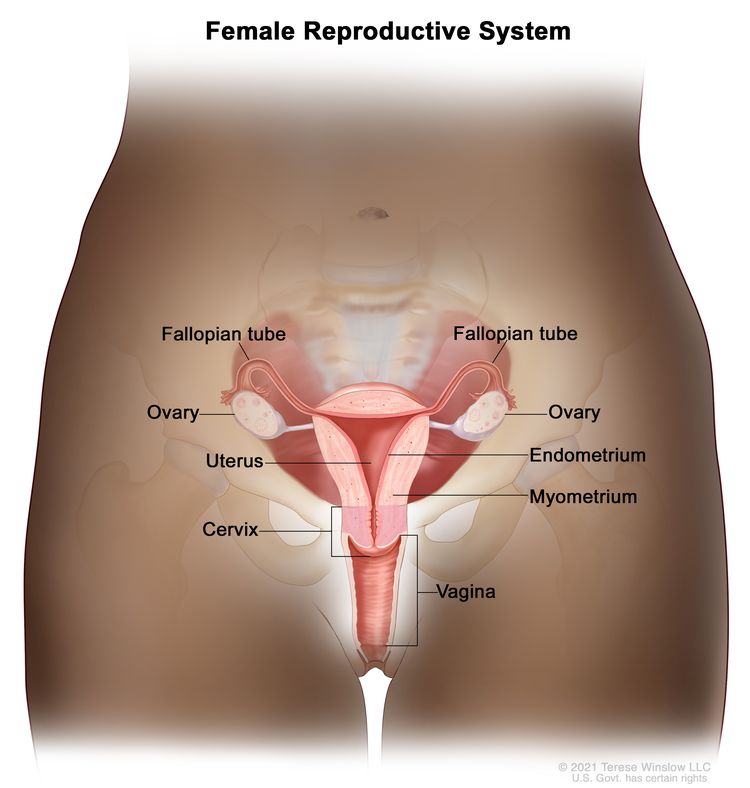
Anatomy of the female reproductive system. The organs in the female reproductive system include the uterus, ovaries, fallopian tubes, cervix, and vagina. The uterus has a muscular outer layer called the myometrium and an inner lining called the endometrium.
Ovarian germ cell tumor is a general name that is used to describe several different types of cancer. The most common ovarian germ cell tumor is called dysgerminoma. See the following PDQ summaries for information about other types of ovarian tumors:
Signs of ovarian germ cell tumor are swelling of the abdomen or vaginal bleeding after menopause.
Ovarian germ cell tumors can be hard to diagnose (find) early. Often there are no symptoms in the early stages, but tumors may be found during regular gynecologic exams (checkups). Check with your doctor if you have:
Tests that examine the ovaries, pelvic area, blood, and ovarian tissue are used to diagnose ovarian germ cell tumor.
In addition to asking about your personal and family health history and doing a physical exam, your doctor may perform the following tests and procedures:
- Pelvic exam: An exam of the vagina, cervix, uterus, fallopian tubes, ovaries, and rectum. A speculum is inserted into the vagina and the doctor or nurse looks at the vagina and cervix for signs of disease. A Pap test of the cervix is usually done. The doctor or nurse also inserts one or two lubricated, gloved fingers of one hand into the vagina and places the other hand over the lower abdomen to feel the size, shape, and position of the uterus and ovaries. The doctor or nurse also inserts a lubricated, gloved finger into the rectum to feel for lumps or abnormal areas.
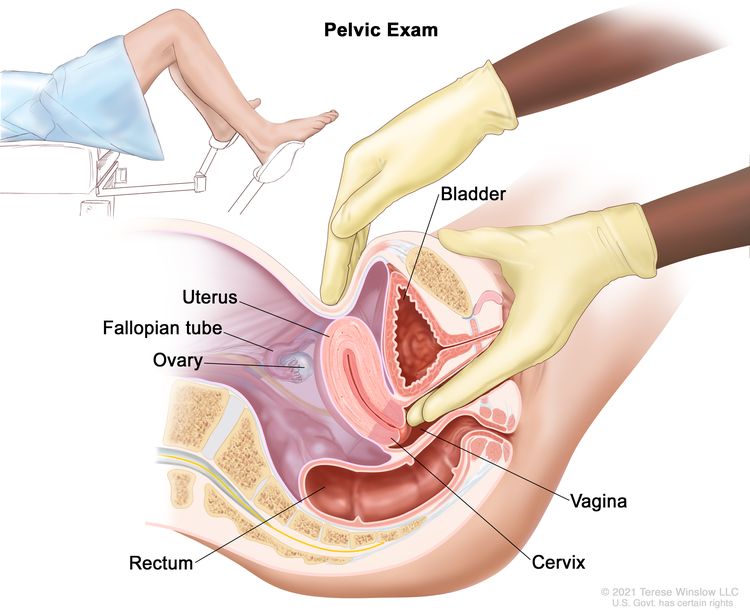
Pelvic exam. A doctor or nurse inserts one or two lubricated, gloved fingers of one hand into the vagina and presses on the lower abdomen with the other hand. This is done to feel the size, shape, and position of the uterus and ovaries. The vagina, cervix, fallopian tubes, and rectum are also checked.
- Laparotomy: A surgical procedure in which an incision (cut) is made in the wall of the abdomen to check the inside of the abdomen for signs of disease. The size of the incision depends on the reason the laparotomy is being done. Sometimes organs are removed or tissue samples are taken and checked under a microscope for signs of disease.
- CT scan (CAT scan): A procedure that makes a series of detailed pictures of areas inside the body, taken from different angles. The pictures are made by a computer linked to an x-ray machine. A dye may be injected into a vein or swallowed to help the organs or tissues show up more clearly. This procedure is also called computed tomography, computerized tomography, or computerized axial tomography.
- Serum tumor marker test: A procedure in which a sample of blood is checked to measure the amounts of certain substances released into the blood by organs, tissues, or tumor cells in the body. Certain substances are linked to specific types of cancer when found in increased levels in the blood. These are called tumor markers. An increased level of alpha fetoprotein (AFP) or human chorionic gonadotropin (HCG) in the blood may be a sign of ovarian germ cell tumor.
Certain factors affect prognosis (chance of recovery) and treatment options.
The prognosis and treatment options depend on:
- The type of cancer.
- The size of the tumor.
- The stage of cancer (whether it affects part of the ovary, involves the whole ovary, or has spread to other places in the body).
- The way the cancer cells look under a microscope.
- The patient’s general health.
Ovarian germ cell tumors are usually cured if found and treated early.
Stages of Ovarian Germ Cell Tumors
Key Points
- After ovarian germ cell tumor has been diagnosed, tests are done to find out if cancer cells have spread within the ovary or to other parts of the body.
- There are three ways that cancer spreads in the body.
- Cancer may spread from where it began to other parts of the body.
- The following stages are used for ovarian germ cell tumors:
- Stage I
- Stage II
- Stage III
- Stage IV
- Ovarian germ cell tumor can recur (come back) after it has been treated.
After ovarian germ cell tumor has been diagnosed, tests are done to find out if cancer cells have spread within the ovary or to other parts of the body.
The process used to find out whether cancer has spread within the ovary or to other parts of the body is called staging. The information gathered from the staging process determines the stage of the disease. Unless a doctor is sure the cancer has spread from the ovaries to other parts of the body, an operation called a laparotomy is done to see if the cancer has spread. The doctor must cut into the abdomen and carefully look at all the organs to see if they have cancer in them. The doctor will cut out small pieces of tissue so they can be checked under a microscope for signs of cancer. The doctor may also wash the abdominal cavity with fluid, which is also checked under a microscope to see if it has cancer cells in it. Usually, the doctor will remove the cancer and other organs that have cancer in them during the laparotomy. It is important to know the stage in order to plan treatment.
Many of the tests used to diagnose ovarian germ cell tumor are also used for staging. The following tests and procedures may also be used for staging:
- PET scan (positron emission tomography scan): A procedure to find malignant tumor cells in the body. A small amount of radioactive glucose (sugar) is injected into a vein. The PET scanner rotates around the body and makes a picture of where glucose is being used in the body. Malignant tumor cells show up brighter in the picture because they are more active and take up more glucose than normal cells do.
- MRI (magnetic resonance imaging): A procedure that uses a magnet, radio waves, and a computer to make a series of detailed pictures of areas inside the body. This procedure is also called nuclear magnetic resonance imaging (NMRI).
- Transvaginal ultrasound exam: A procedure used to examine the vagina, uterus, fallopian tubes, and bladder. An ultrasound transducer (probe) is inserted into the vagina and used to bounce high-energy sound waves (ultrasound) off internal tissues or organs and make echoes. The echoes form a picture of body tissues called a sonogram. The doctor can identify tumors by looking at the sonogram.
There are three ways that cancer spreads in the body.
Cancer can spread through tissue, the lymph system, and the blood:
- Tissue. The cancer spreads from where it began by growing into nearby areas.
- Lymph system. The cancer spreads from where it began by getting into the lymph system. The cancer travels through the lymph vessels to other parts of the body.
- Blood. The cancer spreads from where it began by getting into the blood. The cancer travels through the blood vessels to other parts of the body.
Cancer may spread from where it began to other parts of the body.
When cancer spreads to another part of the body, it is called metastasis. Cancer cells break away from where they began (the primary tumor) and travel through the lymph system or blood.
- Lymph system. The cancer gets into the lymph system, travels through the lymph vessels, and forms a tumor (metastatic tumor) in another part of the body.
- Blood. The cancer gets into the blood, travels through the blood vessels, and forms a tumor (metastatic tumor) in another part of the body.
The metastatic tumor is the same type of tumor as the primary tumor. For example, if an ovarian germ cell tumor spreads to the liver, the tumor cells in the liver are actually cancerous ovarian germ cells. The disease is metastatic ovarian germ cell tumor, not liver cancer.
The following stages are used for ovarian germ cell tumors:
Stage I
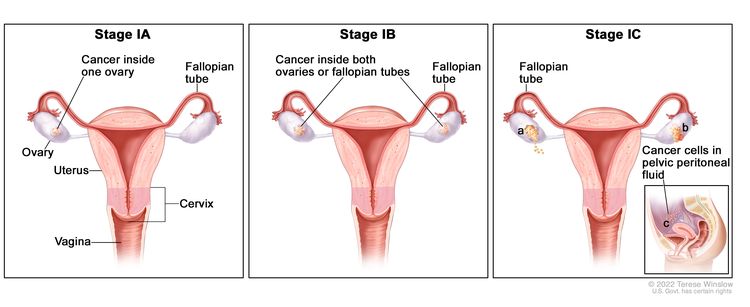
In stage IA, cancer is found inside a single ovary or fallopian tube. In stage IB, cancer is found inside both ovaries or fallopian tubes. In stage IC, cancer is found inside one or both ovaries or fallopian tubes and one of the following is true: (a) either the tumor or the capsule (outer covering) of the ovary has ruptured (broken open), or (b) cancer is also found on the surface of the ovary or fallopian tube, or (c) cancer cells are found in the pelvic peritoneal fluid.
In stage I, cancer is found in one or both ovaries or fallopian tubes. Stage I is divided into stage IA, stage IB, and stage IC.
- Stage IA: Cancer is found inside a single ovary or fallopian tube.
- Stage IB: Cancer is found inside both ovaries or fallopian tubes.
- Stage IC: Cancer is found inside one or both ovaries or fallopian tubes and one of the following is true:
- the tumor ruptured (broke open) during surgery; or
- the capsule (outer covering) of the ovary ruptured before surgery, or there is cancer on the surface of the ovary or fallopian tube; or
- cancer cells are found in the fluid of the peritoneal cavity (the body cavity that contains most of the organs in the abdomen) or in washings of the peritoneum (tissue lining the peritoneal cavity).
Stage II
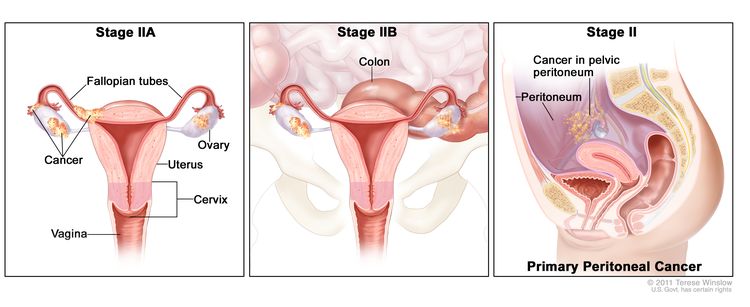
In stage IIA, cancer is found in one or both ovaries or fallopian tubes and has spread to the uterus and/or the fallopian tubes and/or the ovaries. In stage IIB, cancer is found in one or both ovaries or fallopian tubes and has spread to organs in the peritoneal cavity, such as the colon. In primary peritoneal cancer, cancer is found in the pelvic peritoneum and has not spread there from another part of the body.
In stage II, cancer is found in one or both ovaries or fallopian tubes and has spread into other areas of the pelvis, or primary peritoneal cancer is found within the pelvis. Stage II is divided into stage IIA and stage IIB.
- Stage IIA: Cancer has spread from where it first formed to the uterus and/or the fallopian tubes and/or the ovaries.
- Stage IIB: Cancer has spread from the ovary or fallopian tube to organs in the peritoneal cavity (the body cavity that contains most of the organs in the abdomen).

Tumor sizes are often measured in centimeters (cm) or inches. Common food items that can be used to show tumor size in cm include: a pea (1 cm), a peanut (2 cm), a grape (3 cm), a walnut (4 cm), a lime (5 cm or 2 inches), an egg (6 cm), a peach (7 cm), and a grapefruit (10 cm or 4 inches).
Stage III
In stage III, cancer is found in one or both ovaries or fallopian tubes, or is primary peritoneal cancer, and has spread outside the pelvis to other parts of the abdomen and/or to nearby lymph nodes. Stage III is divided into stage IIIA, stage IIIB, and stage IIIC.
- In stage IIIA, one of the following is true:
- Cancer has spread to lymph nodes behind the peritoneum only; or
- Cancer cells that can be seen only with a microscope have spread to the surface of the peritoneum outside the pelvis, such as the omentum (a fold of the peritoneum that surrounds the stomach and other organs in the abdomen). Cancer may have spread to nearby lymph nodes.
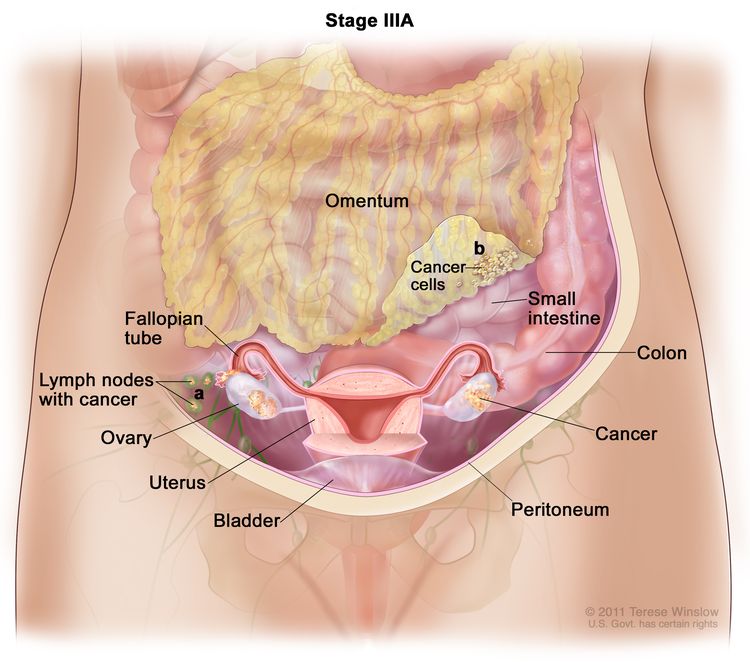
In stage IIIA, cancer is found in one or both ovaries or fallopian tubes and (a) cancer has spread to lymph nodes behind the peritoneum only, or (b) cancer cells that can be seen only with a microscope have spread to the surface of the peritoneum outside the pelvis, such as the omentum. Cancer may have also spread to nearby lymph nodes.
- Stage IIIB: Cancer has spread to the peritoneum outside the pelvis, such as the omentum, and the cancer in the peritoneum is 2 centimeters or smaller. Cancer may have spread to lymph nodes behind the peritoneum.
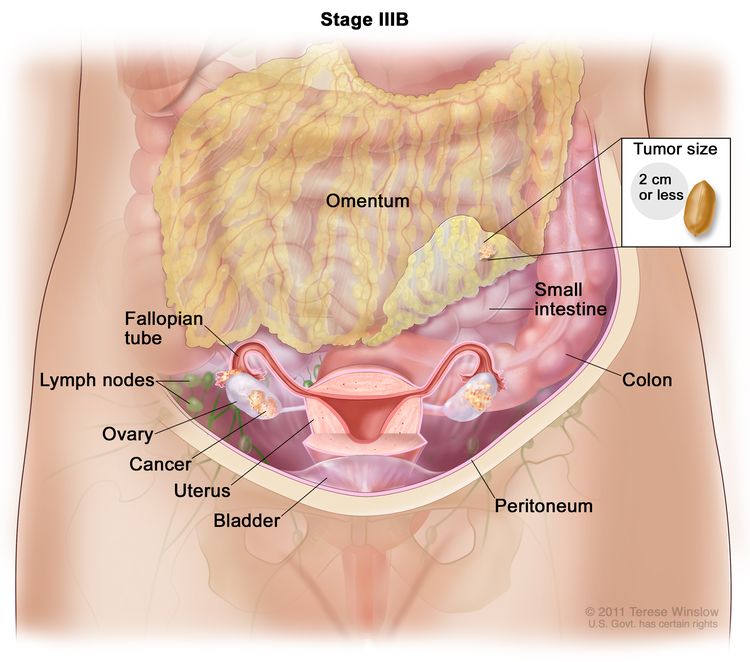
In stage IIIB, cancer is found in one or both ovaries or fallopian tubes and has spread to the peritoneum outside the pelvis, such as the omentum. The cancer in the omentum is 2 centimeters or smaller. Cancer may have also spread to lymph nodes behind the peritoneum.
- Stage IIIC: Cancer has spread to the peritoneum outside the pelvis, such as the omentum, and the cancer in the peritoneum is larger than 2 centimeters. Cancer may have spread to lymph nodes behind the peritoneum or to the surface of the liver or spleen.
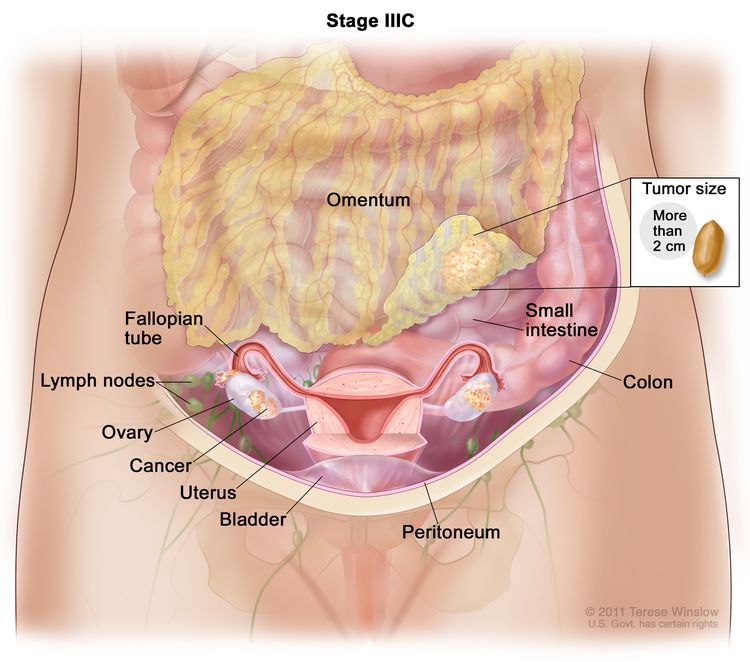
In stage IIIC, cancer is found in one or both ovaries or fallopian tubes and has spread to the peritoneum outside the pelvis, such as the omentum. The cancer in the omentum is larger than 2 centimeters. Cancer may have also spread to lymph nodes behind the peritoneum or to the surface of the liver or spleen (not shown).
Stage IV
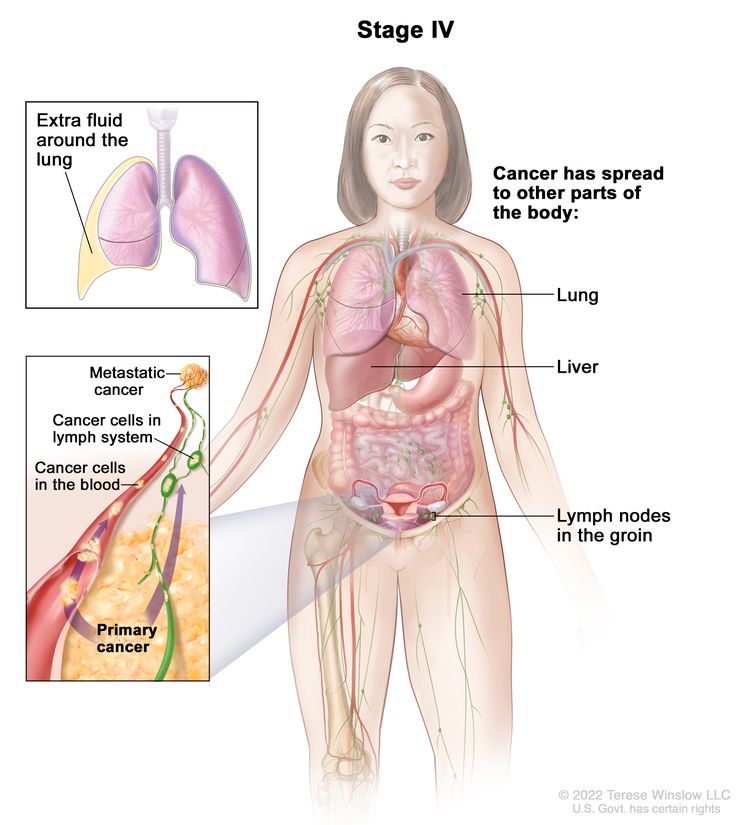
In stage IV, cancer has spread beyond the abdomen to other parts of the body. In stage IVA, cancer cells are found in extra fluid that builds up around the lungs. In stage IVB, cancer has spread to organs and tissues outside the abdomen, including the lung, liver, and lymph nodes in the groin.
In stage IV, cancer has spread beyond the abdomen to other parts of the body. Stage IV is divided into stage IVA and stage IVB.
Ovarian germ cell tumor can recur (come back) after it has been treated.
The cancer may come back in the other ovary or in other parts of the body.
Treatment Option Overview
Key Points
- There are different types of treatment for patients with ovarian germ cell tumors.
- The following types of treatment are used:
- Surgery
- Observation
- Chemotherapy
- Radiation therapy
- New types of treatment are being tested in clinical trials.
- High-dose chemotherapy with bone marrow transplant
- New treatment options
- Treatment for ovarian germ cell tumors may cause side effects.
- Patients may want to think about taking part in a clinical trial.
- Patients can enter clinical trials before, during, or after starting their cancer treatment.
- Follow-up tests may be needed.
There are different types of treatment for patients with ovarian germ cell tumors.
Different types of treatment are available for patients with ovarian germ cell tumor. Some treatments are standard (the currently used treatment), and some are being tested in clinical trials. A treatment clinical trial is a research study meant to help improve current treatments or obtain information on new treatments for patients with cancer. When clinical trials show that a new treatment is better than the standard treatment, the new treatment may become the standard treatment. Patients may want to think about taking part in a clinical trial. Some clinical trials are open only to patients who have not started treatment.
The following types of treatment are used:
Surgery
Surgery is the most common treatment of ovarian germ cell tumor. A doctor may take out the cancer using one of the following types of surgery.
- Unilateral salpingo-oophorectomy: A surgical procedure to remove one ovary and one fallopian tube.
- Total hysterectomy: A surgical procedure to remove the uterus, including the cervix. If the uterus and cervix are taken out through the vagina, the operation is called a vaginal hysterectomy. If the uterus and cervix are taken out through a large incision (cut) in the abdomen, the operation is called a total abdominal hysterectomy. If the uterus and cervix are taken out through a small incision (cut) in the abdomen using a laparoscope, the operation is called a total laparoscopic hysterectomy.
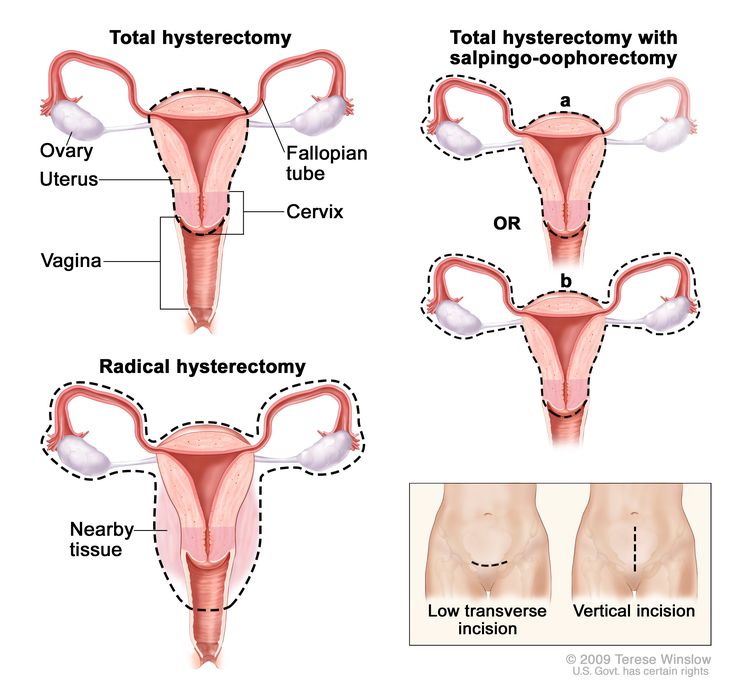
Hysterectomy. The uterus is surgically removed with or without other organs or tissues. In a total hysterectomy, the uterus and cervix are removed. In a total hysterectomy with salpingo-oophorectomy, (a) the uterus plus one (unilateral) ovary and fallopian tube are removed; or (b) the uterus plus both (bilateral) ovaries and fallopian tubes are removed. In a radical hysterectomy, the uterus, cervix, both ovaries, both fallopian tubes, and nearby tissue are removed. These procedures are done using a low transverse incision or a vertical incision.
- Bilateral salpingo-oophorectomy: A surgical procedure to remove both ovaries and both fallopian tubes.
- Tumor debulking: A surgical procedure in which as much of the tumor as possible is removed. Some tumors cannot be completely removed.
After the doctor removes all the cancer that can be seen at the time of the surgery, some patients may be given chemotherapy or radiation therapy after surgery to kill any cancer cells that are left. Treatment given after the surgery, to lower the risk that the cancer will come back, is called adjuvant therapy.
After chemotherapy for an ovarian germ cell tumor, a second-look laparotomy may be done. This is similar to the laparotomy that is done to find out the stage of the cancer. Second-look laparotomy is a surgical procedure to find out if tumor cells are left after primary treatment. During this procedure, the doctor will take samples of lymph nodes and other tissues in the abdomen to see if any cancer is left. This procedure is not done for dysgerminomas.
Observation
Observation is closely watching a patient’s condition without giving any treatment unless signs or symptoms appear or change.
Chemotherapy
Chemotherapy is a cancer treatment that uses drugs to stop the growth of cancer cells, either by killing the cells or by stopping them from dividing. When chemotherapy is taken by mouth or injected into a vein or muscle, the drugs enter the bloodstream and can reach cancer cells throughout the body (systemic chemotherapy). When chemotherapy is placed directly into the cerebrospinal fluid, an organ, or a body cavity such as the abdomen, the drugs mainly affect cancer cells in those areas (regional chemotherapy). Combination chemotherapy is treatment using more than one anticancer drug. The way the chemotherapy is given depends on the type and stage of the cancer being treated.
For more information, see Drugs Approved for Ovarian, Fallopian Tube, or Primary Peritoneal Cancer.
Radiation therapy
Radiation therapy is a cancer treatment that uses high-energy x-rays or other types of radiation to kill cancer cells or keep them from growing. External radiation therapy uses a machine outside the body to send radiation toward the area of the body with cancer.
New types of treatment are being tested in clinical trials.
This summary section describes treatments that are being studied in clinical trials. It may not mention every new treatment being studied. Information about clinical trials is available from the NCI website.
High-dose chemotherapy with bone marrow transplant
High-dose chemotherapy with bone marrow transplant is a method of giving very high doses of chemotherapy and replacing blood-forming cells destroyed by the cancer treatment. Stem cells (immature blood cells) are removed from the bone marrow of the patient or a donor and are frozen and stored. After the chemotherapy is completed, the stored stem cells are thawed and given back to the patient through an infusion. These reinfused stem cells grow into (and restore) the body’s blood cells.
New treatment options
Combination chemotherapy (the use of more than one anticancer drug) is being tested in clinical trials.
Treatment for ovarian germ cell tumors may cause side effects.
For information about side effects caused by treatment for cancer, visit our Side Effects page.
Patients may want to think about taking part in a clinical trial.
For some patients, taking part in a clinical trial may be the best treatment choice. Clinical trials are part of the cancer research process. Clinical trials are done to find out if new cancer treatments are safe and effective or better than the standard treatment.
Many of today's standard treatments for cancer are based on earlier clinical trials. Patients who take part in a clinical trial may receive the standard treatment or be among the first to receive a new treatment.
Patients who take part in clinical trials also help improve the way cancer will be treated in the future. Even when clinical trials do not lead to effective new treatments, they often answer important questions and help move research forward.
Patients can enter clinical trials before, during, or after starting their cancer treatment.
Some clinical trials only include patients who have not yet received treatment. Other trials test treatments for patients whose cancer has not gotten better. There are also clinical trials that test new ways to stop cancer from recurring (coming back) or reduce the side effects of cancer treatment.
Clinical trials are taking place in many parts of the country. Information about clinical trials supported by NCI can be found on NCI’s clinical trials search webpage. Clinical trials supported by other organizations can be found on the ClinicalTrials.gov website.
Follow-up tests may be needed.
As you go through treatment, you will have follow-up tests or check-ups. Some tests that were done to diagnose or stage the cancer may be repeated to see how well the treatment is working. Decisions about whether to continue, change, or stop treatment may be based on the results of these tests.
Some of the tests will continue to be done from time to time after treatment has ended. The results of these tests can show if your condition has changed or if the cancer has recurred (come back).
Treatment of Stage I Ovarian Germ Cell Tumors
For information about the treatments listed below, see the Treatment Option Overview section.
Treatment depends on whether the tumor is a dysgerminoma or another type of ovarian germ cell tumor.
Treatment of dysgerminoma may include:
- Unilateral salpingo-oophorectomy with or without lymphangiography or CT scan.
- Unilateral salpingo-oophorectomy followed by observation.
- Unilateral salpingo-oophorectomy followed by radiation therapy.
- Unilateral salpingo-oophorectomy followed by chemotherapy.
Treatment of other ovarian germ cell tumors may include:
- unilateral salpingo-oophorectomy followed by careful observation; or
- unilateral salpingo-oophorectomy, sometimes followed by combination chemotherapy.
Use our clinical trial search to find NCI-supported cancer clinical trials that are accepting patients. You can search for trials based on the type of cancer, the age of the patient, and where the trials are being done. General information about clinical trials is also available.
Treatment of Stage II Ovarian Germ Cell Tumors
For information about the treatments listed below, see the Treatment Option Overview section.
Treatment depends on whether the tumor is a dysgerminoma or another type of ovarian germ cell tumor.
Treatment of dysgerminoma may include:
- total abdominal hysterectomy and bilateral salpingo-oophorectomy followed by radiation therapy or combination chemotherapy; or
- unilateral salpingo-oophorectomy followed by chemotherapy.
Treatment of other ovarian germ cell tumors may include:
- Unilateral salpingo-oophorectomy followed by combination chemotherapy.
- Second-look laparotomy (surgery done after primary treatment to see if tumor cells remain).
- A clinical trial of a new treatment.
Use our clinical trial search to find NCI-supported cancer clinical trials that are accepting patients. You can search for trials based on the type of cancer, the age of the patient, and where the trials are being done. General information about clinical trials is also available.
Treatment of Stage III Ovarian Germ Cell Tumors
For information about the treatments listed below, see the Treatment Option Overview section.
Treatment depends on whether the tumor is a dysgerminoma or another type of ovarian germ cell tumor.
Treatment of dysgerminoma may include:
- Total abdominal hysterectomy and bilateral salpingo-oophorectomy, with removal of as much of the cancer in the pelvis and abdomen as possible.
- Unilateral salpingo-oophorectomy followed by chemotherapy.
Treatment of other ovarian germ cell tumors may include:
- Total abdominal hysterectomy and bilateral salpingo-oophorectomy, with removal of as much of the cancer in the pelvis and abdomen as possible. Chemotherapy will be given before and/or after surgery.
- Unilateral salpingo-oophorectomy followed by chemotherapy.
- Second-look laparotomy (surgery done after primary treatment to see if tumor cells remain).
- A clinical trial of a new treatment.
Use our clinical trial search to find NCI-supported cancer clinical trials that are accepting patients. You can search for trials based on the type of cancer, the age of the patient, and where the trials are being done. General information about clinical trials is also available.
Treatment of Stage IV Ovarian Germ Cell Tumors
For information about the treatments listed below, see the Treatment Option Overview section.
Treatment depends on whether the tumor is a dysgerminoma or another type of ovarian germ cell tumor.
Treatment of dysgerminoma may include:
- Total abdominal hysterectomy and bilateral salpingo-oophorectomy followed by chemotherapy, with removal of as much of the cancer in the pelvis and abdomen as possible.
- Unilateral salpingo-oophorectomy followed by chemotherapy.
Treatment of other ovarian germ cell tumors may include:
- Total abdominal hysterectomy and bilateral salpingo-oophorectomy, with removal of as much of the cancer in the pelvis and abdomen as possible. Chemotherapy will be given before and/or after surgery.
- Unilateral salpingo-oophorectomy followed by chemotherapy.
- Second-look laparotomy (surgery done after primary treatment to see if tumor cells remain).
- A clinical trial of a new treatment.
Use our clinical trial search to find NCI-supported cancer clinical trials that are accepting patients. You can search for trials based on the type of cancer, the age of the patient, and where the trials are being done. General information about clinical trials is also available.
Treatment of Recurrent Ovarian Germ Cell Tumors
For information about the treatments listed below, see the Treatment Option Overview section.
Treatment depends on whether the tumor is a dysgerminoma or another type of ovarian germ cell tumor.
Treatment of dysgerminoma may include:
- Chemotherapy with or without radiation therapy.
Treatment of other ovarian germ cell tumors may include:
- Chemotherapy.
- Surgery with or without chemotherapy.
- A clinical trial of high-dose chemotherapy followed by bone marrow transplant.
- A clinical trial of a new treatment.
Use our clinical trial search to find NCI-supported cancer clinical trials that are accepting patients. You can search for trials based on the type of cancer, the age of the patient, and where the trials are being done. General information about clinical trials is also available.
To Learn More About Ovarian Germ Cell Tumors
For more information from the National Cancer Institute about ovarian germ cell tumors, see:
- Ovarian, Fallopian Tube, and Primary Peritoneal Cancer Home Page
- Drugs Approved for Ovarian, Fallopian Tube, or Primary Peritoneal Cancer
For general cancer information and other resources from the National Cancer Institute, visit:
About This PDQ Summary
About PDQ
Physician Data Query (PDQ) is the National Cancer Institute's (NCI's) comprehensive cancer information database. The PDQ database contains summaries of the latest published information on cancer prevention, detection, genetics, treatment, supportive care, and complementary and alternative medicine. Most summaries come in two versions. The health professional versions have detailed information written in technical language. The patient versions are written in easy-to-understand, nontechnical language. Both versions have cancer information that is accurate and up to date and most versions are also available in Spanish.
PDQ is a service of the NCI. The NCI is part of the National Institutes of Health (NIH). NIH is the federal government’s center of biomedical research. The PDQ summaries are based on an independent review of the medical literature. They are not policy statements of the NCI or the NIH.
Purpose of This Summary
This PDQ cancer information summary has current information about the treatment of ovarian germ cell tumors. It is meant to inform and help patients, families, and caregivers. It does not give formal guidelines or recommendations for making decisions about health care.
Reviewers and Updates
Editorial Boards write the PDQ cancer information summaries and keep them up to date. These Boards are made up of experts in cancer treatment and other specialties related to cancer. The summaries are reviewed regularly and changes are made when there is new information. The date on each summary ("Updated") is the date of the most recent change.
The information in this patient summary was taken from the health professional version, which is reviewed regularly and updated as needed, by the PDQ Adult Treatment Editorial Board.
Clinical Trial Information
A clinical trial is a study to answer a scientific question, such as whether one treatment is better than another. Trials are based on past studies and what has been learned in the laboratory. Each trial answers certain scientific questions in order to find new and better ways to help cancer patients. During treatment clinical trials, information is collected about the effects of a new treatment and how well it works. If a clinical trial shows that a new treatment is better than one currently being used, the new treatment may become "standard." Patients may want to think about taking part in a clinical trial. Some clinical trials are open only to patients who have not started treatment.
Clinical trials can be found online at NCI's website. For more information, call the Cancer Information Service (CIS), NCI's contact center, at 1-800-4-CANCER (1-800-422-6237).
Permission to Use This Summary
PDQ is a registered trademark. The content of PDQ documents can be used freely as text. It cannot be identified as an NCI PDQ cancer information summary unless the whole summary is shown and it is updated regularly. However, a user would be allowed to write a sentence such as “NCI’s PDQ cancer information summary about breast cancer prevention states the risks in the following way: [include excerpt from the summary].”
The best way to cite this PDQ summary is:
PDQ® Adult Treatment Editorial Board. PDQ Ovarian Germ Cell Tumors Treatment. Bethesda, MD: National Cancer Institute. Updated <MM/DD/YYYY>. Available at: https://www.cancer.gov/types/ovarian/patient/ovarian-germ-cell-treatment-pdq. Accessed <MM/DD/YYYY>. [PMID: 26389363]
Images in this summary are used with permission of the author(s), artist, and/or publisher for use in the PDQ summaries only. If you want to use an image from a PDQ summary and you are not using the whole summary, you must get permission from the owner. It cannot be given by the National Cancer Institute. Information about using the images in this summary, along with many other images related to cancer can be found in Visuals Online. Visuals Online is a collection of more than 3,000 scientific images.
Disclaimer
The information in these summaries should not be used to make decisions about insurance reimbursement. More information on insurance coverage is available on Cancer.gov on the Managing Cancer Care page.
Contact Us
More information about contacting us or receiving help with the Cancer.gov website can be found on our Contact Us for Help page. Questions can also be submitted to Cancer.gov through the website’s E-mail Us.
Updated:
Source URL: https://www.cancer.gov/node/4365/syndication
Source Agency: National Cancer Institute (NCI)
Captured Date: 2013-09-14 09:02:10.0








